Collection of materials relating to neuro-ophthalmology as part of the Neuro-Ophthalmology Virtual Education Library.
NOVEL: https://novel.utah.edu/
TO
| Title | Creator | Description | Subject | ||
|---|---|---|---|---|---|
| 1 |
 |
Branch Retinal Artery Occlusion with Multiple Retinal Emboli | Kathleen B. Digre, MD; James J. Corbett, MD | Slideshow describing condition. | Retinal Emboli; Emboli |
| 2 |
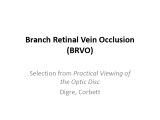 |
Branch Retinal Vein Occlusion (BRVO) | Kathleen B. Digre, MD; James J. Corbett, MD | Slideshow describing condition. | Occlusion |
| 3 |
 |
Branch Retinal Artery Occlusion | Kathleen B. Digre, MD; James J. Corbett, MD | Slideshow describing condition. | Occlusion |
| 4 |
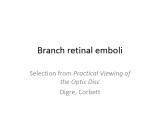 |
Branch Retinal Emboli | Kathleen B. Digre, MD; James J. Corbett, MD | Slideshow describing condition. | Emboli |
| 5 |
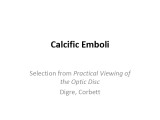 |
Calcific Emboli | Kathleen B. Digre, MD; James J. Corbett, MD | Slideshow describing condition. | Emboli |
| 6 |
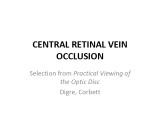 |
Central Retinal Vein Occlusion | Kathleen B. Digre, MD | Slideshow describing condition. | Occlusion |
| 7 |
 |
Craniopharyngioma and Optic Atrophy | Kathleen B. Digre, MD; James J. Corbett, MD | Slideshow describing condition. | Craniopharayngioma; Otpic Atrophy |
| 8 |
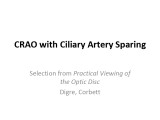 |
CRAO with Ciliary Artery Sparing | Kathleen B. Digre, MD; James J. Corbett, MD | Slideshow describing condition. | CRAO |
| 9 |
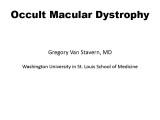 |
Central Cone Dystrophy Occult Macular Dystrophy | Gregory Van Stavern, MD | Slideshow describing condition of Central Cone Dystrophy Occult Macular Dystrophy | Central Cone Distrophy; Macular Dystrophy; Occult Macular Dystrophy |
| 10 |
 |
Pupillary reflex and the APD | Wade Crow, MD | Illustrations describing pupillary reflex. | Pupillary Reflex, APD |
| 11 |
 |
Vasospastic Amaurosis Fugax | Kathleen B. Digre, MD; James J. Corbett, MD | Slideshow describing condition. | Vasospastic Amaurosis Fugax |
| 12 |
 |
Acquired Hyperopia | AAO/NANOS - American Academy of Ophthalmology / North American Neuro-Ophthalmology Society | Choroidal folds may result from choroidal tumors, compression on the eye wall from thyroid ophthalmopathy, orbital pseudotumor, orbital tumor, posterior scleritis, hypotony, scleral laceration, retinal detachment, marked hyperopia, or secondary to papilledema. Intraocular pressure measurements, refr... | Acquired Hyperopia |
| 13 |
 |
Fat Emboli | Kathleen B. Digre, MD; James J. Corbett, MD | Slideshow describing condition. | Emboli |
| 14 |
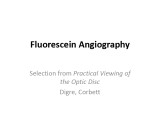 |
Fluorescein Angiography | Kathleen B. Digre, MD; James J. Corbett, MD | Fluorescein angiography in neuro-ophthalmology. | Fluorescein Angiography; History |
| 15 |
 |
Fibrin-Platelet Emboli | Kathleen B. Digre, MD; James J. Corbett, MD | Slideshow describing condition. | Emboli; Platelet Emboli |
| 16 |
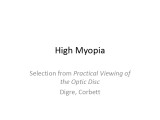 |
High Myopia | Kathleen B. Digre, MD; James J. Corbett, MD | Slideshow describing condition. | Myopia |
| 17 |
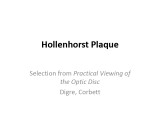 |
Hollenhorst Plaque | Kathleen B. Digre, MD; James J. Corbett, MD | Slideshow describing condition. | Hollenhorst Plaque |
| 18 |
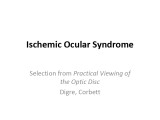 |
Ischemic Ocular Syndrome | Kathleen B. Digre, MD; James J. Corbett, MD | Slideshow describing condition. | Ischemic Ocular Syndrome |
| 19 |
 |
Best's Vittelform Maculopathy | Gregory P. Van Stavern, MD | This 14 year old presented with decreased vision, headaches and central scotomas. She was found to have bilateral papilledema related to IIH and also Best's vitilliform maculopathy. The maculas are commonly described as having a "fried egg" sunny side up appearance. | Best Macular Dystrophy |
| 20 |
 |
Septo-Optic Dysplasia | Kathleen B. Digre, MD; James J. Corbett, MD | Slideshow describing the condition. | Septo-optic Dysplasia |
| 21 |
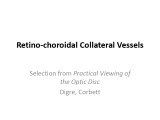 |
Retino-choroidal Collateral Vessels | Kathleen B. Digre, MD; James J. Corbett, MD | Slideshow describing condition. | Collateral Vessels |
| 22 |
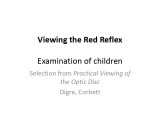 |
Viewing the Red Reflex | Kathleen B. Digre, MD; James J. Corbett, MD | Slideshow describing eye examination of children. | Eye Examination |
| 23 |
 |
Papilledema 2013 | Kathleen B. Digre, MD | Objectives: What types of disc findings can be confused for papilledema List the features of true disc swelling Describe the tests you would order to evaluate and w/u papilledema List differential diagnosis of papilledema Describe possible treatments for papilledema (medical and surgical) | Papilledema |
| 24 |
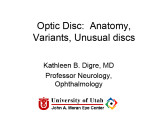 |
Optic Disc Anatomy, Variants, and Usual Discs | Kathleen B. Digre, MD | Examination of optic disc, disc anatomy, disc variation. | Optic Disc; Normal Disc Anatomy |
| 25 |
 |
Retino-choroidal Collaterals Due to Meningioma | Kathleen B. Digre, MD; James J. Corbett, MD | Slideshow describing condition. | Meningioma; Menigioma Treatment |
